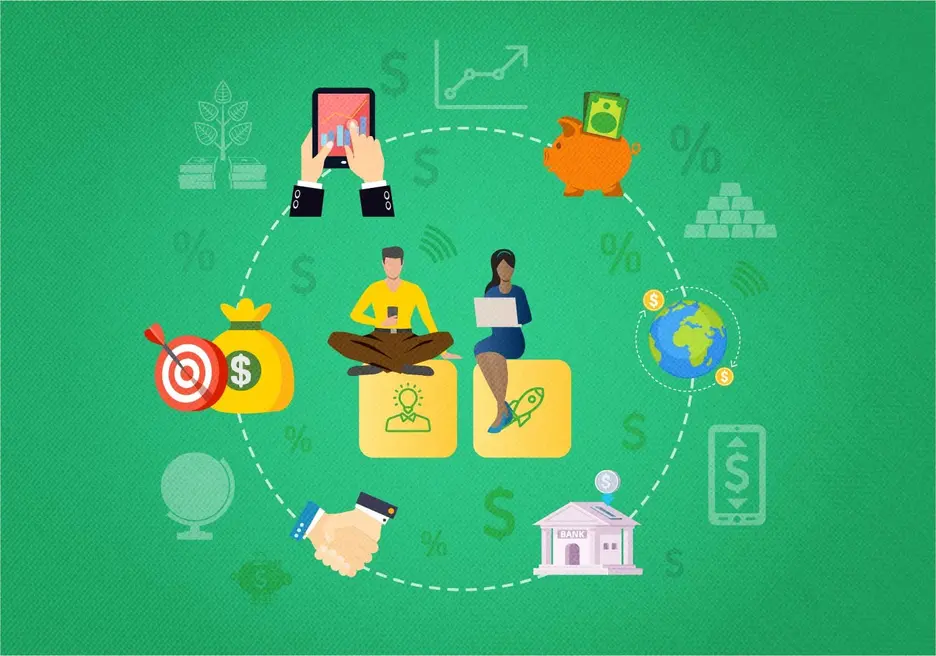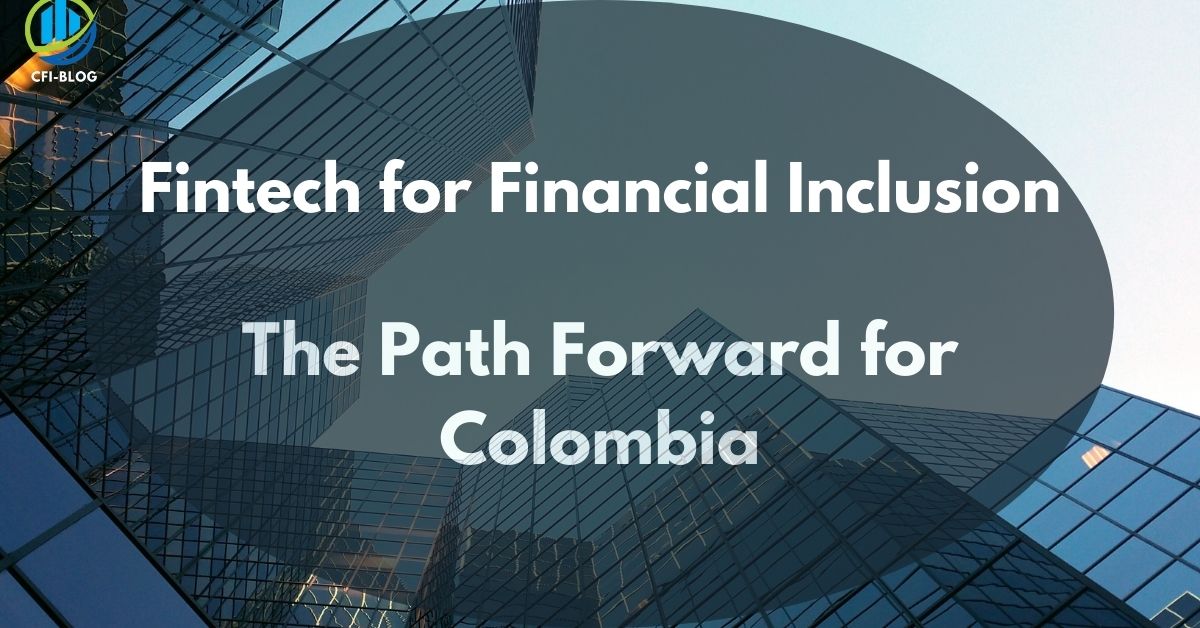Despite the immense technological improvements in various financial sectors around the world in various countries, financial exclusion is still one of the biggest crises in most developing and underdeveloped countries. Due to problems like reachability, illiteracy, and poor income status among various groups of people like women, small-scale farmers, and micro, small, and medium-sized enterprises (SMEs) is not satisfactory. Fintech for financial inclusion is a very important aspect of economic growth, as it brings stability. Financial exclusion drastically hampers the community of people from earning money, protecting themselves during crises, building an efficient healthcare system for themself, etc.
Similarly, with the technological advancement in Colombia, there is a large population of people who are still unbanked. The government of Colombia has understood the importance of financial inclusion and its impact on the economy and hence has taken many measures to incorporate financial inclusion. Factors like inter-institutional strategies, and customer diligence had been helping Colombia to comprise financial Inclusion. This article will provide in-depth knowledge about financial inclusion, how it has affected Colombia, and what are the challenges faced by them in incorporating Financial Inclusion.
What is Financial Inclusion?

The meaning of Fintech for financial inclusion means incorporating various initiatives and services available to a wide range of populations despite their background, economic status, and net worth. In order to perform financial Inclusion, it is important to unfasten all the barriers that are stopping Financial Inclusion. This process of removing the barrier is known as inclusive finance. Financial Inclusion helps in bringing stability to a country and helps in improving the lives of the people and improving the lives of small-scale farmers, businesses, and enterprises.
Reports published by the World Bank have shown how financial inclusion is beneficial to people and how it can help millions of people worldwide who are unbanked or not a part of any financial institution. The benefits provided by a financial institution, like debit cards, credit cards, and savings accounts, enable you to lend money and carry on transactions, which eventually help you to invest in various healthcare, educational, and other sectors, uplifting the economy. For this reason, Tanzania launches a national financial inclusion framework, to help the overall economy grow.
Benefits of Financial Inclusion

Relating the context to the Asian scenario, India’s economy is currently the fifth largest in the world. It surpasses several of the developed nations. Notwithstanding this success, a sizable portion of the population is still without access to banking services. The best solution to this problem is fintech financial planning. Yet, the concept of financial inclusion is new to India. Financial inclusion in India would entail providing all poor individuals with the widest possible access to inexpensive financial services.
International Experts believe that financial inclusiveness should apply to everyone and not just one group. If a service is offered in a rural area, it ought to be offered in any underdeveloped cities that are present in an urban area. Additional people will open savings accounts, transfer money between accounts, take out loans, etc. as a result of the focus on economic inclusivity.
These capabilities can be used to grow your company, construct a home, and do other things. progressively dispelling the notion that prejudice and credit screening are mutually exclusive. By boosting the national economy, such items will ultimately benefit society. The general quality of life for the entire population will significantly improve.
- Rural residents will have access to bank transactions, savings accounts, debit cards, etc. A quick verification procedure, a fingerprint scan, and photo id evidence can accomplish this.
- When more funds are held in banks, the private economy (cash economy) would decline.
- Accessibility to a bank account encourages people to save more, which benefits the national economy.
- Payments made to a receiver’s bank would be feasible, which will help you avoid numerous issues that arise when you move funds in reality.
- Individuals from remote communities can borrow money to pursue their dreams thanks to the availability of financial products, which can lead to business. The population shall be more independent and enjoy a higher level of living.
Drawbacks of Financial Inclusion
- High operating expenses: It is well known that not all accounts opened by low-income households are regularly used by them. According to one estimate, 58{% of the nineteen crore accounts created remain without transactions. The upkeep of these assets places a significant financial and operational load on the banks. Another figure places the yearly expense of keeping an inactive credit at around Rs 10,000. Calculating the overall cost would result in figures in the hundreds of billions.
- Getting right to the point: Increased consumer participation leads to fierce rivalry, which is further fueled by the openness of international bank markets and the introduction of new subcategories (transaction institutions, small financing banks) into the system. As a result, there is fierce price competition, which lowers the efficiency of the whole banking sector.
- Substitution of moneylender amenities: Money changers have traditionally been vilified for taking advantage of the underprivileged by imposing recover the amount under duress and collecting exorbitant interest rates (and over 120% yearly in several cases). But the essential takeaway is that a lending institution is essentially a services company that is nearby and prepared to provide customers with cash even at late times. The financial sector has grown at a rate that is unheard of as a result.
How Does Financial Inclusion Work?
Financial exclusion has been a prevalent problem in various countries for a long time due to numerous reasons like poor literacy, lower economic standards, and stability. To overcome all these issues steps were taken that would encourage people to take up financial services. Various Fintech companies have helped to overcome all these challenges and provided a profitable turnover at affordable costs and fees.
Cashless payment methods, low-fee advisors, and peer-to-peer funding are some of the reasons that have enabled most of the FinTech developments. These cashless transactions have helped a lot of people who were unbanked and were unable to take loans for various developmental needs due to a good credit score or maintaining good creditworthiness.
Although various opportunities were introduced in numerous countries, there are still many countries who are lacking basic financial services to access the smooth flow of money and maintain transaction money. The World Bank took an initiative to increase inclusivity, which aims to provide financial accessibility around the world so that the number of people who are unbanked decreases, with an increase in fintech financial inclusion. Another example of a push for financial inclusion can be the Pell Grants provided by the U.S. Government to solve the student loan situation in the US.
Why is Financial Inclusion Important?
People may experience life-threatening financial difficulties if they cannot access even preliminary banking services. They may be unable to receive some payments, be forced to pay more for essential utilities like energy, and be prohibited from purchasing items because they lack convenient ways to make transactions. Fintech financial inclusion gives a way to store money, make payments and net profit, build savings, get credit, and make investments, thus including modules crucial for individuals and businesses.
Access like this is essential for buying securities and establishing monetary sustainability. Larger economic inclusion for smaller companies is crucial as it may raise local standards of life and contribute to the creation of further jobs. Many of the nations continue to see rapid growth, for instance, it has been a cautionary tale to India’s financial inclusion push.
However, after more than ten years of expansion, some African nations are experiencing difficulties. There is no justification for laziness. The growth and participation of fintech financial inclusion must be a part of the effort to implement policies that can either sustain or revive growth. In fact, a study by the IMF found that greater inclusiveness stimulates economic growth. For once, more progress and greater inclusivity are both attainable goals.
How Did Financial Inclusion Affect Colombia?
It is advantageous to conduct business in this sector in Colombia. The nation receives high marks from the Global Microscope for having favorable conditions for fintech and financial inclusion. According to the report, 76% of the Colombian population is using Fintech services. This rating is in part due to the availability of straightforward savings accounts, favorable legislation, and a strong agent banking system.
A significant regulatory change made in 2015 allowed non-banks to get banking licenses, opening up the market to mobile money business models. According to the conventional indicator of financial brand equity, Colombians have increased inclusiveness, with about 80% owning products.
Despite the fact that more adults now own at most one financial instrument, new figures from Colombia’s top fintech and financial inclusion regulator revealed that the growth of active users has not been encouraging. Lack of faith is one of the main obstacles, which can be removed by providing a user-friendly experience.
- Colombia made consistent progress toward financial inclusion as a result of bold legal reforms, high-level governmental leadership of the microfinance agenda, and the business sector’s backing of policy objectives. Banca de las Oportunidades (BdO) and the Superintendencia Financiera (SFC) claim that Colombia achieved its accessibility goal two years early (85% of people using at least one financial product3). Adults in Colombia had at least one investment product as of March 2021, and 87.5% had at minimum one savings account.
- Though mobile wallets and COVID-19-related constraints have helped online wallets gain popularity, cash still accounts for the majority of retail payments, and digital means and activity accounts are seen as being more expensive and less secure than cash. Concerning the use of quick transactions, which aid in encouraging financial inclusion and the penetration of electronic payments across numerous domains, Columbia lags behind local competitors like Brazil and Mexico. Especially microenterprises experience substantial funding gaps that cannot be filled by the availability of micro-credit, nor can MSMEs turn to peer-to-peer lending or fundraising.
- As a prerequisite for digitization to increase fintech and financial inclusion, structural changes must be continued and accelerated; this task necessitates the creation of more efficient state institutions. Since the organizational structure for financial intermediation was recently updated, it is important to make clear how government policy and the recently established inter-sectoral commission are related. In line with its mandate to facilitate seamless domestic and international payments, the BR should describe its contribution to the financial inclusion strategy. The financial inclusion goal should be coordinated more closely with digital inclusion and information governance objectives. To promote consensus and collaboration among all stakeholders, a national payments council (NPC) must be established.
- In order to strengthen the recovery of the costs, there should be a reasonable mix between sector collaboration and competition. Officials should keep an eye on how recent revisions are affecting membership and fees. In conjunction with the competition commission, they must examine the expenses that organizations with certain market dominance inflict on their users and the industries they serve and make any necessary changes. Officials should design a fast transaction with a time-bound strategy for the business to remove obstacles preventing the growth of lead to significant savings and to accomplish set goals after consulting with the sector. If this doesn’t work, the BR could have to think about playing a new fast payment function.
- Towards financial intermediation, it is important to further harness factors that underprivileged sections use to acquire and use activity funds and online wallets, such as reduced accounts (DBM) and federal subsidies. By rolling out the existing system built around public bidding and switching to cash subsidies to recipients into financial transactions of their choice, there remains a significant amount of potential to digitize social state benefits. Measures to ensure widespread involvement in the ACH system, impartiality towards lenders, and justice must be taken alongside ongoing initiatives.
- Although a third of these businesses see access to capital as a main impediment, small businesses in Colombia enjoy elevated amounts of access to basic investment instruments. Above the worldwide and regional standards, more than 99% of small businesses in Colombia reported experiencing a savings or checking account, and 55% found a financial statement or line of credit. Cash flow is financed by vendors or credit cards in a significant portion of small businesses (63%), which is significantly more than the local people have (48% and 25%). Collateral was required for 46 percent of mortgages to smaller companies in Colombia, which is less than the global and regional percentages (57% and 73%, respectively).
How Did Colombian Fintech Movizzon Help in Financial Inclusion?
Like BaganMart, Myanmar’s first e-commerce platform is helping promote financial inclusion in Myanmar, Movizzon is one of the most popular Fintech companies in Colombia that has been helping Colombia to adopt fintech financial planning. In 2014, the business was established in Chile. However, in 2016, the company’s founders moved the location of the company’s headquarters to Bogotá, Colombia, as it is easier to travel to clients around the region from Bogotá’s location, which is halfway between Mexico and Chile.
More crucially, according to Antonio Arancibia, co-founder of Movizzon, the finch industry in Colombia provides an excellent “environment” for expanding his business. It has a strong position in “permanent development” and is gaining power, he claims. He is implying that Colombia’s fintech sector has already experienced significant growth. Thousands of smartphones are purchased by the corporation, and two apps, those of its own and those of its bank customers are installed on each one.
Thereafter, the fake phones are taken over by Movizzon’s app, which logs into the banks’ apps every few minutes and performs operations like money transfers and credit card payments. Movizzon’s technology instantly notifies the banks of any issues, such as login failures or system freezes, and frequently does so through Messenger or email.
Banks can now address issues as they arise thanks to continuous feeds of app bugs, which eliminates the need for them to handle a large number of angry consumers in one go. By highlighting problem trends spanning months and years, Movizzon has already assisted banks to prevent their mobile apps from collapsing. And over 20 banks, including BBVA, Banco Ita, and Banco Falabella, in 10 Latin American nations are among its customers, which attests to its success.
What are the Challenges Faced By Financial Inclusion?
- It has been determined from research on fund transfer for migrants and surveys carried out by the World Bank Group in Morocco and Mozambique that the research party’s lack of information hindered them from consuming the proper goods and services that meet their specific demands. By raising these people’s financial literacy levels, we can influence their ability to make wiser fintech financial planning and choose the products that will best meet their needs. Also, they will learn how to use the different channels at their disposal for banking needs more effectively. In other words, it is possible to enhance the acceptance of novel bank accounts through the use of more cost-efficient and successful strategies, which will increase overall savings.
- While the finance sector like digital payments and digital currencies have proliferated in an effort to increase access to financial services, there is still a shortage of consumer confidence in the security and dependability of these recently developed systems. A meeting was held where the African board fellows deliberated on the subject of overindebtedness; it is a huge problem for microfinance as well.
- Lack of official identification documents is one of the main barriers preventing those without bank accounts from using basic financial services. A valid ID is typically needed before someone may create a bank account in most nations. IDs are indeed required to transfer money and apply for government aid. Hence, government agencies must streamline and ease the procedure for getting a formal Identity card in order to make financial services more readily available for the financially excluded.
- Around 1.1 billion of the 2 billion financially excluded people worldwide comprise women, according to the most recent data. Financial inclusion in Nigeria lagging behind in this financial freedom is a matter of big concern not only for the nation but for the people outside the country. While looking for banking services in emerging nations, poor women living in remote areas, in general, confront special challenges. According to a World Bank study, women have a lesser likelihood of obtaining bank loans, although they make up a higher portion of the self-employed population in developing countries. According to an IFC study, financial institutions deny credit to more women than males because of an absence of collateral or a bad credit record.
Frequently Asked Questions (FAQs)
Q1. How can Fintech help with financial inclusion?
A new tool to promote financial literacy is Fintech. The absence of middlemen never entirely trusted along only with the fact that nearly all transactions can now be completed using a user-friendly tool. Smartphones are closing the gap here between the financial sector and several young consumers. Research from organizations like the World Bank and the OECD, among many others, demonstrates how using investment instruments is hampered by a lack of economic literacy. Fintech gets rid of this obstacle.
Q2. What is the role of Fintech in the Financial Sector?
Fintech is the term for the process through which financial services providers integrate new into their products to enhance the usability and customer experience. It essentially functions by disentangling these companies’ products and creating fresh opportunities for companies.
Q3. How is Fintech changing the financial industry?
Fintech may increase finance industry productivity, provide superior and more specialized services and goods, and expand access to financial services in emerging nations. Both demand and availability for financial products have been significantly altered by fintech. Fintechs haven’t taken the place of established financial services companies, instead, they’ve expanded the market with new goods and services.
Q4. How does Fintech change the trajectory of the financial market?
In addition to creating new credit markets, fintech businesses including Internet banks also take over the stockholders of some established banking firms, especially small to medium-sized banks, which reduces the number of loans that traditional banks issue.
Bottom Line
Financial Inclusion is very important for economic development as it boosts the economy by providing several financial services which are not available in many countries. Fintech financial planning gives stability to any economy and gives them a chance to survive in various economic crises and social instability. It provides basic lending facilities to poor, small-scale farmers, and women around the world who are unbanked and are devoid of basic services.
Despite all the technological improvements and introduction of cashless payments, it has been reported there are more than 1.7 billion people globally, who are still unbanked. So, to fill the gap between these and to ensure the reachability of financial services, it is very important to make the whole process more user-friendly and affordable.
Author Profile

- Jonas Taylor is a financial expert and experienced writer with a focus on finance news, accounting software, and related topics. He has a talent for explaining complex financial concepts in an accessible way and has published high-quality content in various publications. He is dedicated to delivering valuable information to readers, staying up-to-date with financial news and trends, and sharing his expertise with others.
Latest entries
 BlogOctober 30, 2023Exposing the Money Myth: Financing Real Estate Deals
BlogOctober 30, 2023Exposing the Money Myth: Financing Real Estate Deals BlogOctober 30, 2023Real Estate Success: Motivation
BlogOctober 30, 2023Real Estate Success: Motivation BlogOctober 28, 2023The Santa Claus Rally
BlogOctober 28, 2023The Santa Claus Rally BlogOctober 28, 2023Build Your Team – the Importance of Networking for Traders
BlogOctober 28, 2023Build Your Team – the Importance of Networking for Traders

